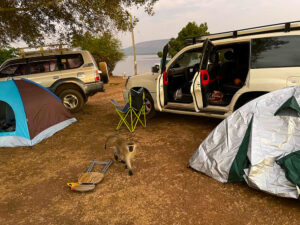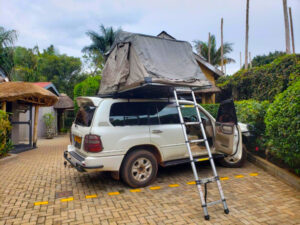Wildlife Viewing by Self-drive in Congo – Game watching experience with self drive Congo
Are you planning to visit Congo for game watching experience. Experience the thrill of wildlife viewing by self-drive in Congo. A complete guide to wildlife viewing by self-drive in Congo. Embarking on a self-drive game/wildlife viewing in Congo presents wildlife enthusiasts a great opportunity to explore the country’s abundant wildlife in the wild. The Democratic Republic of Congo (DRC) is blessed with unique wildlife that range from its varying habitats from savanna to rainforest environments.

Congo is one of the least explored destinations in Africa yet endowed by diverse wildlife worth exploring on guided safaris or self-drive wildlife viewing excursion. Your complete guide to self-drive wildlife viewing in Congo provides deep insight into the different destinations to visit, various wildlife, best time to go for self-drive tours, what to pack, and getting there.
Wildlife Viewing by Self-drive in Congo
Congo provides refuge to diverse wildlife species in the varying habitats. Some of the wildlife to see on Congo tour include forest elephants, buffaloes, mountain gorillas, eastern lowland gorillas, okapis, golden monkeys, bonobos, and many bird species.
Birds to explore during wildlife viewing tour in Congo include peacock, grant parrot, yellow-billed stork, black stork, palm nut vulture, cattle egrets, black bellied bustard, and many others.
Where to go for Congo self-drive wildlife viewing safari
The Democratic Republic of Congo (DRC) features different amazing places worth visiting for wildlife viewing safaris. They include forest and savanna dominated protected areas such as Kahuzi-Biega National Park, Okapi Wildlife Reserve, Virunga National Park, Lola Ya Bonobo Sanctuary, and others.
Kahuzi-Biega National Park
Kahuzi-Biega National Park is lying south of Kivu and takes its name from the scenic Mt. Kahuzi and Biega. It is a designated UNESCO World Heritage Site and leading lowland gorilla trekking destination. Kahuzi-Biega is currently the only place where eastern lowland gorillas can be visited and the park features a good number of habituated gorilla groups.
Gorilla families to track in Kahuzi-Biega include Mpungwe group, Chimanuka gorilla family, Mugahuka gorilla group, Nganwe, and Bonnani group. Trekking these gorilla groups requires participants to have a valid gorilla permit and each is issued at USD 450 per person.
Visitors on eastern lowland gorilla trek should expect to begin their day with a briefing on the gorilla trekking guidelines, allocation of gorilla families by park official, and allocation of park ranger guides. This will be done at the park offices/headquarters then you can begin the actual trekking at around 8:00 am. The entire gorilla trek will go for about 2-5 hours which covers an hour for interaction with a family of eastern lowland gorillas.
Kahuzi-Biega can be accessed from the heart of Kigali via Bukavu or fly to Goma Airport in Congo and start your road trip to the park.
Virunga National Park
Located in eastern DRC and established in 1925, Virunga National Park is home to the endangered mountain gorillas. Virunga is a recognized UNESCO World Heritage Site and is biologically diverse. The 7800 sq. km Virunga National Park shelters over 200 mammals and 708 bird species, as well as 78 amphibians and 109 reptile species. The notable wildlife to explore in the Virunga National Park include okapis, elephants, mountain gorillas, hippos, lions, and others.
Mountain gorilla trekking is the leading primate adventure awaiting you to experience on Congo safari in the Virunga National Park. Eight habituated gorilla groups are available for trekking in the Virunga National Park including Humba gorilla family, Bageni, Mapuwa, Lulengo, Kabirizi, Nyakamwe, Munyaga, and others. Each of these gorilla families is visited by a maximum of 8 (eight) visitors.
Besides mountain gorilla trekking adventures, Virunga National Park is also popular for its thrilling Nyiragongo Volcano hike. Mount Nyiragongo is 3470 meters and hikes can take about 4-5 hours to the powerful lava crater lake.
Virunga National Park can be accessed for gorilla holiday from Kigali or you fly up to Goma International Airport and drive to the park. A 4×4 safari vehicle is the most ideal means that guarantees you a smooth road trip to and from the Virunga National Park in Congo.
Garamba National Park
Garamba National Park is home to world’s 4 largest land mammals that is the rhinos, elephants, giraffes, and hippos. Garamba is a designated UNESCO Site and provides refuge to the highest concentration of African elephants. The park extends up to 5200 sq. km and it also shelters hyenas, lions, plus many antelope species. There are also numerous birds to explore on a tour in Garamba National Park including white-backed vulture, hooded vultures, spur winged plovers, wattled plovers, white backed pelicans, black crake, and long-tailed cormorants.
The ideal safari activities to engage in the Garamba National Park include bird watching, game viewing, boat tours, and others.
Salonga National Park
Salonga National Park is the biggest rainforest protected area in Africa and is among the very few UNESCO World Heritage Sites in Congo. The park is home to diverse wildlife including dwarf chimpanzees, forest elephants, peacocks, De Brazza’s monkeys, Allen’s swamp monkeys, golden-bellied mangabey, red colobus monkeys, leopards, sitatunga, elephants, long-tailed pangolins, hippos, and more.
Lola Ya Bonobos Sanctuary
Lola Ya Bonobos Sanctuary should be a must-visit place on self-drive wildlife viewing tour in Congo. The sanctuary protects the endangered bonobos also known as the pygmy chimpanzees. It is the only sanctuary with the bonobos and is found close to Kinshasa in the Democratic Republic of Congo.
Okapi Wildlife Reserve
Okapi is a UNESCO World Heritage Site and home to a huge concentration of primates and birds. Okapi is an extensive reserve, established in 1992 and is lying in the northeastern end of the Democratic Republic of the Congo. It provides refuge to over 101 mammal species including the okapi –the forest giraffe; 376 species of birds.
When to visit Congo on self drive journey
Congo is open to visitors all year round. However, the dry season is the most preferred time of the year thanks to its favorable weather conditions. The dry season occurs from June to September –the months characterized by low or no rainfall with the forest floor kept drier.
What to pack for self drive adventure tour in Congo
A complete packing list for your wildlife viewing by self-drive in Congo include emergency kit/first aid kit, sunscreen and moisturizer, insect repellents, toiletries, daypack, bottled water, GPS, a camera, comfortable and waterproof hiking boots, etc.


